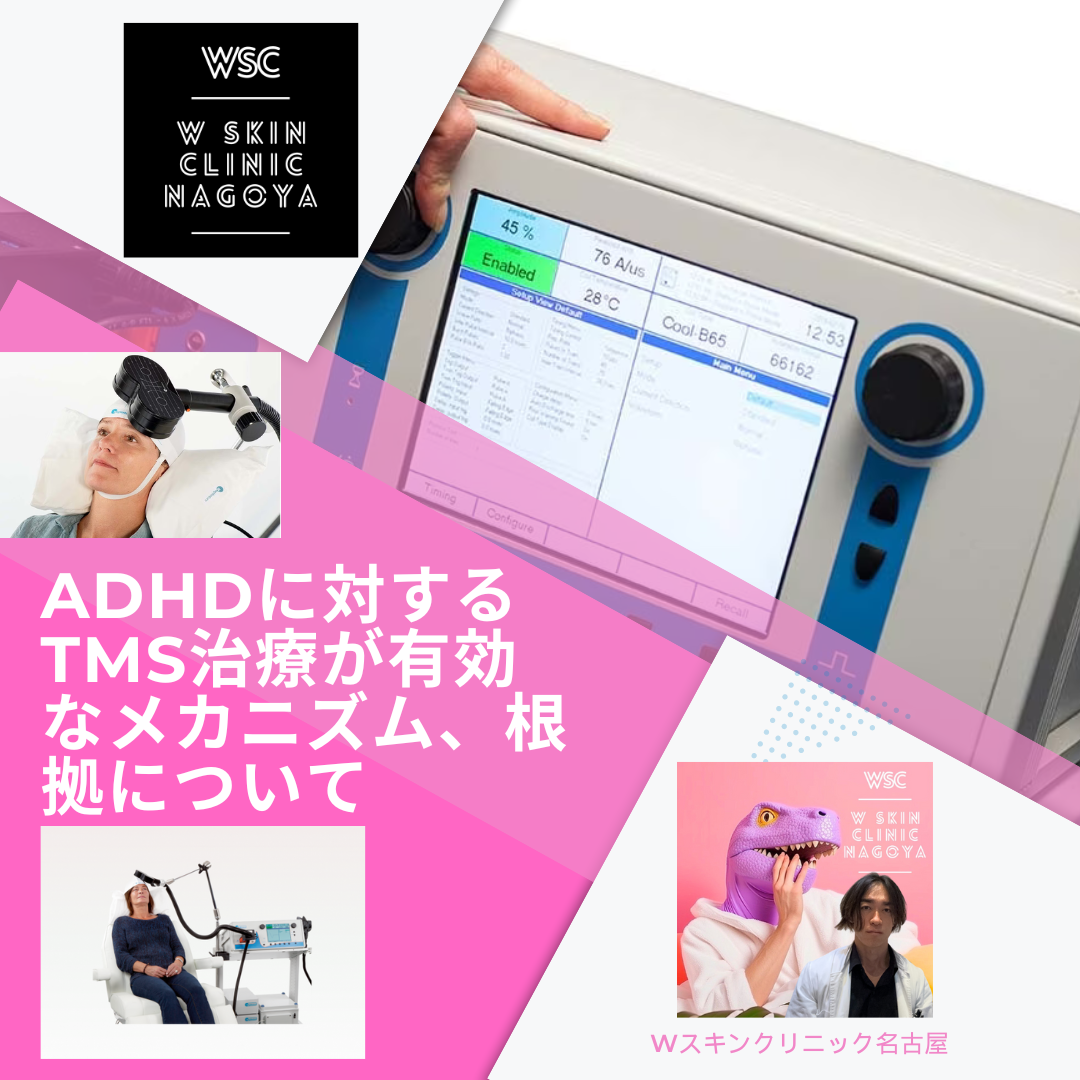NEWSお知らせ
2024.07.20|ブログ
ADHDに対するTMS治療の有効性、メカニズム、改善される症状、その根拠について、名古屋の美容皮膚科医が解説

ADHDに対するTMS治療の有効性、メカニズム、改善される症状、その根拠について、名古屋の美容皮膚科医が解説
こんにちは、Wスキンクリニック名古屋、院長の加藤晃司です。
今回は、ADHDに対するTMS治療の有効性、メカニズム、改善される症状、その根拠について解説します。
最近は、子供から大人まで、ADHDの方がTMS治療を受けられています。
ADHD内服は他の精神疾患に比べると使いやすい方だと思いますが、それでも使う量を減らしたり、使わないで症状を改善できた方がいいとは思います。
神経伝達物質以外の面でもTMSは効果を発揮するため、内服とは異なる治療となります。
<TMS治療の特徴>
**経頭蓋磁気刺激(TMS)**は、非侵襲的に脳内の特定の部位を磁場で刺激する治療法です。ADHD(注意欠陥・多動性障害)に対する治療法としても研究が進められています。
(1)メカニズム
TMS治療は、脳内の神経活動を調整し、特定の脳領域の機能を改善することを目的としています。以下は、ADHDに対するTMSのメカニズムです:
①前頭前野の刺激:
ADHDの患者は、前頭前野の機能低下が報告されています。TMSは、この領域をターゲットにして刺激を与え、神経活動を正常化させます。
②神経伝達物質の調整:
TMSは、ドーパミンやノルアドレナリンなどの神経伝達物質のバランスを調整することができます。これらの伝達物質は、注意力や集中力、衝動抑制に関与しています。
③神経可塑性の促進:
磁気刺激によってシナプスの可塑性が促進され、新しい神経回路の形成が促されます。これにより、注意力や行動制御の改善が期待されます。
(2)改善される症状
ADHDに対するTMS治療は、以下の症状の改善が期待されています:
①注意力の向上:
前頭前野の機能改善により、注意力の向上が見られます。これにより、学習や仕事での集中力が増します。
②多動性の軽減:
過剰な活動性が抑えられ、落ち着いた行動ができるようになります。これにより、社会的な適応能力が向上します。
③衝動性の抑制:
衝動的な行動が減少し、より計画的で理性的な行動ができるようになります。これにより、人間関係や日常生活での問題が減少します。
(3)根拠
①臨床試験:
複数の臨床試験において、TMSがADHD症状の改善に有効であることが示されています。例えば、2018年に発表された研究では、ADHD患者に対するTMS治療が注意力、衝動性、多動性の改善に効果的であることが報告されました。
②メタアナリシス:
TMS治療の効果を評価するためのメタアナリシスも行われており、全体的にTMSがADHD症状の改善に寄与することが示されています。これにより、TMSの有効性が裏付けられています。
③神経画像研究:
fMRIやPETスキャンなどの神経画像研究により、TMSが前頭前野の活動を増加させることが確認されています。これにより、TMSが神経活動に与える影響が視覚的に示されています。
まとめ
今回は、ADHDに対するTMS治療の有効性、メカニズム、改善される症状、その根拠について解説しました。
ADHDに対するTMS治療は、前頭前野の神経活動を調整し、神経伝達物質のバランスを整え、神経可塑性を促進することで、注意力の向上、多動性の軽減、衝動性の抑制といった症状の改善が期待されます。臨床試験やメタアナリシス、神経画像研究によってその有効性が支持されており、ADHD治療の一環として有望なアプローチとされています。
内服以外でも治療効果を上げたい、可能な限り内服を減らす、もしくは中止したいと考えている方には有効な選択肢となるはずです。
Wスキンクリニック名古屋での、TMS治療はこちら
https://www.w-clinic-nagoya.com/tms
Wスキンクリニック名古屋
理事長 加藤晃司
当院では無料でスタッフカウンセリングを行なっております。
お気軽にご予約くださいませ
Wスキンクリニック名古屋 (美容皮膚科)
https://www.w-clinic-nagoya.com/
〒461-0005 愛知県名古屋市東区東桜 2-4-1 第3コジマビル6F
TEL 052-7377-7117(10:00~19:00)
LINE ID @w.nagoya
高岳駅より徒歩4分 / 新栄町駅より徒歩5分
お車でお越しの方
名鉄協商パーキングチケットをお渡しいたしますので、クリニック近くのパーキングをご利用ください。
Is TMS Treatment Effective for ADHD? Mechanisms, Symptoms Improved, and Supporting Evidence Explained by a Psychiatrist in Nagoya
Hello, I’m Dr. Koji Kato, Director of W Skin Clinic Nagoya.
Today, I will explain the effectiveness, mechanisms, and symptoms improved by TMS treatment for ADHD, along with the supporting evidence.
Recently, people with ADHD, from children to adults, have been receiving TMS treatment.
ADHD medications are generally easier to use compared to other psychiatric drugs, but reducing the amount or improving symptoms without medication would be preferable.
TMS is effective beyond neurotransmitter modulation, making it a different approach from medication.
Features of TMS Treatment
Transcranial Magnetic Stimulation (TMS) is a non-invasive treatment that stimulates specific parts of the brain using magnetic fields. It has been researched as a treatment for ADHD (Attention Deficit Hyperactivity Disorder).
- Mechanisms
TMS treatment aims to regulate brain activity and improve the function of specific brain regions. Here are the mechanisms by which TMS works for ADHD:
1.1 Stimulation of the Prefrontal Cortex:
ADHD patients often have impaired prefrontal cortex function. TMS targets and stimulates this area to normalize neural activity.
1.2 Regulation of Neurotransmitters:
TMS can balance neurotransmitters such as dopamine and norepinephrine, which are involved in attention, focus, and impulse control.
1.3 Promotion of Neuroplasticity:
Magnetic stimulation promotes synaptic plasticity, encouraging the formation of new neural circuits, leading to improvements in attention and behavior control.
- Symptoms Improved
TMS treatment for ADHD is expected to improve the following symptoms:
2.1 Enhanced Attention:
Improvement in prefrontal cortex function leads to better attention, increasing focus in studies and work.
2.2 Reduced Hyperactivity:
Excessive activity is controlled, allowing for calmer behavior, which enhances social adaptability.
2.3 Impulse Control:
Reduction in impulsive behavior leads to more planned and rational actions, decreasing problems in relationships and daily life.
- Evidence
3.1 Clinical Trials:
Several clinical trials have demonstrated that TMS is effective in improving ADHD symptoms. For example, a study published in 2018 reported that TMS treatment improved attention, impulsivity, and hyperactivity in ADHD patients.
3.2 Meta-Analysis:
Meta-analyses evaluating the effectiveness of TMS treatment have shown that TMS contributes to the improvement of ADHD symptoms, supporting its effectiveness.
3.3 Neuroimaging Studies:
Neuroimaging studies using fMRI and PET scans have confirmed that TMS increases activity in the prefrontal cortex, visually demonstrating the impact of TMS on neural activity.
Summary
Today, I explained the effectiveness, mechanisms, symptoms improved, and supporting evidence for TMS treatment for ADHD.
TMS treatment for ADHD adjusts neural activity in the prefrontal cortex, balances neurotransmitters, and promotes neuroplasticity, resulting in improved attention, reduced hyperactivity, and better impulse control. Clinical trials, meta-analyses, and neuroimaging studies support its effectiveness, making it a promising approach in ADHD treatment.
For those who want to enhance treatment effects beyond medication, reduce medication use, or avoid medication altogether, TMS treatment is a valuable option.
For more information, please feel free to contact our clinic.




